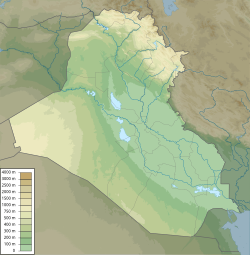Al-Arba'een Mosque
| Al-Arba'een Mosque | |
|---|---|
جامع الأربعين شهيداً | |
 The mosque before its 2014 destruction | |
| Religion | |
| Affiliation | Sunni Islam (former) |
| Ecclesiastical or organisational status | Mosque (11th century–2014) |
| Status | Destroyed (under reconstruction) |
| Location | |
| Location | Tikrit, Saladin Governorate |
| Country | Iraq |
Location of the mosque in Iraq | |
 | |
| Geographic coordinates | 34°35′56″N 43°40′34″E / 34.59889°N 43.67611°E |
| Architecture | |
| Type | Mosque architecture |
| Founder | Amr ibn Jundab Al-Ghafari |
| Completed | 5th century AH (11th century CE) |
| Destroyed | 24 September 2014 |
| Specifications | |
| Length | 47 m (154 ft) |
| Width | 47 m (154 ft) |
| Dome(s) | Five (since destroyed) |
| Minaret(s) | One (since destroyed) |
| Shrine(s) | Two:
|
| Materials | Gravel; plaster |
The Al-Arba'een Mosque (Arabic: جامع الأربعين شهيداً) is a former Sunni mosque, that was located in the city of Tikrit, in the Saladin Governorate of Iraq. It contained a shrine for Amr ibn Jundab Al-Ghafari, and another shrine for Sitt Nafisa.[1] The mosque was destroyed by ISIL on 24 September 2014.
History
[edit]The building dates from the 5th century AH (11th century CE).[1] The name of the mosque, "Al-Arba'een" (The Forty), is derived[2] from a belief that forty martyrs killed during an Islamic conquest of Tikrit[3] and were buried under the mosque, although this claim is contested as reports of the forty graves are weak.[1]
The building was used as an Islamic university in 1262 CE.[4]
Architecture
[edit]The mosque building was a square shape, with five domes. Each side was approximately 47 metres (154 ft) long.[1] Its dimensions are 36.5 by 35.5 metres (120 by 116 ft).[2] Gravel and plaster were mostly used to construct the building[1] and the two venerated rooms are 10 metres (33 ft) tall.[1]
One of these venerated rooms was a shrine that contained a tomb of Amr ibn Jundab Al-Ghafari,[3] a companion of the Rashidun caliph Umar ibn Al-Khattab. There was also a cellar in the building which is believed by locals to house the resting place of a female saint, Sitt Nafisa.[5]
The mosque was destroyed by the Islamic State of Iraq and the Levant in 2014 by explosives.[4] The explosion completely destroyed the shrines but did not damage the rest of the mosque. The surrounding cemetery was damaged.
See also
[edit]
References
[edit]- ^ a b c d e f الأحمدي, مصطفى. عبد الله بن المعتم وعمرو بن جندب الغفاري أبرز المدفونين فيه.. ما قصة مزار الأربعين صحابيا في تكريت؟. Al Jazeera (in Arabic). Retrieved June 7, 2022.
- ^ a b تكريت, مدونة (July 19, 2013). تكريت: مزار الاربعين في تكريت الموقع و التاريخ. تكريت (in Arabic). Retrieved June 7, 2022.
- ^ a b بالصور .. تحفة إسلامية تحتضن مرقد صحابي تعاني الإهمال في تكريت. قناه السومرية العراقية (in Arabic). Retrieved June 7, 2022.
- ^ a b "ISIS destroys shrine in Iraq amid U.S. strikes". Al Arabiya English. September 25, 2014. Retrieved June 7, 2022.
- ^ موسوعة شذرات المطر ..مدونة المهندس رائد جعفر مطر : مزار الاربعين ولي في تكريت. موسوعة شذرات المطر ..مدونة المهندس رائد جعفر مطر (in Arabic). February 25, 2019. Retrieved June 9, 2022.
External links
[edit]![]() Media related to Al-Arba'een Mosque at Wikimedia Commons
Media related to Al-Arba'een Mosque at Wikimedia Commons

